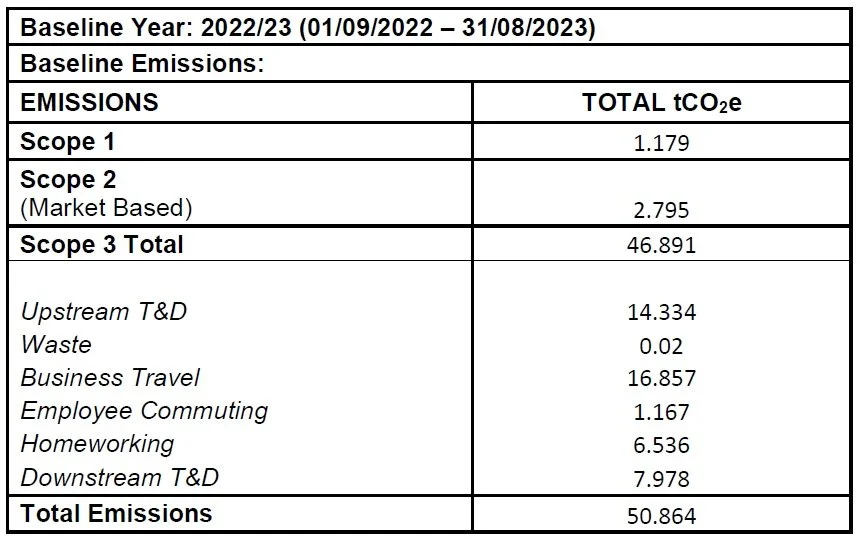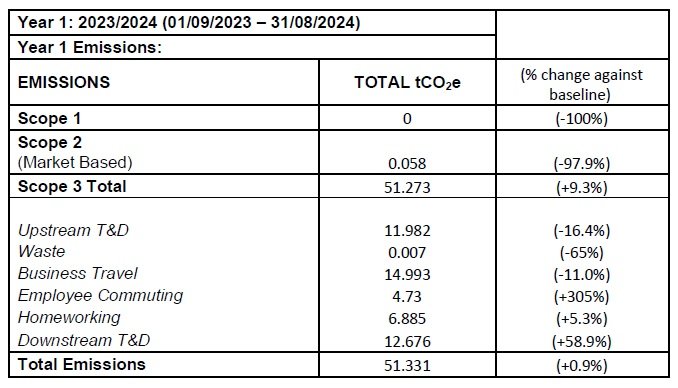Carbon Reduction Plan
Commitment to achieving Net Zero
Icentia Limited is committed to achieving Net Zero emissions by 2050.
Baseline Emissions Footprint
Baseline emissions are a record of the greenhouse gases that have been produced in the past and were produced prior to the introduction of any strategies to reduce emissions.
Baseline emissions are the reference point against which emissions reduction can be measured.
Current Emmission Reporting
Emissions Reduction Targets
To progress towards achieving Net Zero, Icentia Ltd. will endeavour to reach the following carbon reduction targets.
We project that carbon emissions will decrease over the five years from baseline to 41.45 tCO2e by 2028. This is a reduction of 18.5%, with a projected yearly reduction of 3.7%. We will utilise any future opportunities on our carbon reduction journey wherever possible to achieve Net Zero ahead of schedule.
The graph below shows Icentia Ltd’s projected carbon emissions over the next 25 years to reach Net Zero by 2050. Icentia Ltd commits to reduce avoidable emissions to as close to zero as possible and then offset any residual emissions.
In year 1 Scope 1 emissions have been eliminated and Scope 2 reduced by almost 98%. Due to a change in demand for services that require more product transport and an expansion in sales territory, Scope 3 emissions have increased. This has resulted in a slight increase in overall emissions by 0.465 tCO2e.
In lieu of increased emissions in Year 1 Icentia limited has offset 10 tonnes of carbon to stay in line with our reduction targets. This carbon offsetting was achieved through supporting a local wetland restoration scheme by planting several trees at the Skipbridge Wetland Reserve near York. UK wetland is one of the most important habitats for UK biodiversity and we hope to continue supporting this or similar projects on an annual basis.
Carbon Reduction Projects
Completed and Ongoing Carbon Reduction Initiatives
The following environmental management measures were completed, introduced during the 2022-23 baseline study period or are ongoing.
Our portable CardioSTAT heart monitor continues to reduce the need for patients to travel to and from hospitals lowering transport emissions. This contrasts with traditional ECG Holter use.
We maintain carbon measuring procedures to monitor emissions and identity areas for improvement on a regular basis.
We are working with suppliers wherever possible to reduce emissions and achieve Net Zero by 2050.
We continue to review options to update and install carbon reduction technology in our office spaces to reduce on-site emissions.
Most employees continue to work solely from home reducing travel related emissions.
Icentia Limited’s main office is now entirely powered by 100% renewable energy which has eliminated scope 1 and reduced scope 2 emissions to almost zero.
Icentia has increased the number of electric vehicles across its Sales Team and continues to encourage the use of hybris & electric vehicles.
Planned Carbon Reduction Initiatives
Over the course of our Net Zero journey, we hope to implement further measures which will continue to lower carbon emissions. Below are some of the examples of the initiatives we are discussing.
Consider a Switch from air freight to sea freight for transatlantic shipping
Air freight emits significantly more carbon dioxide than sea freight.
Decentralise manufacturing of our product
Explore the possibility of moving elements of our device manufacturing process and logistics to the UK and Europe to reduce emissions.
Switch to a carbon neutral delivery service
Icentia Limited is already using a carbon neutral delivery service for some international shipments and can expand this to include all deliveries by 2050.
Create an electric vehicle lease scheme for sales staff
Emissions related to sales staff travelling across the country to different clients is significant. Some Icentia Limited staff are already using electric vehicles but this can be expanded to include all sales staff.
Install an EV charging point on site
Icentia Limited will investigate the options to install an EV charging point on site. This will encourage the use of electric vehicles.
Cycle to work scheme: Increase commuting by cycling
Currently 50% of office workers cycle to work. Introducing a cycle to work schemes would aim to encourage a further reduction in vehicle based commuting.
Reduce all meetings in person
Reduce in person meetings using communication technology and therefore reducing the need for vehicle based travel.
Eliminate/reduce all business air travel
The need for travel between the UK, Ireland and Canada within the business can be reduced and potentially entirely avoided and replaced with remote meetings and communication.
Offsetting
Icentia will explore the possibility of gradually offsetting emissions between now and 2050 or offset once implemented carbon reduction measures have reduced emissions as far as possible.
Declaration and Sign Off
This Carbon Reduction Plan has been completed in accordance with PPN 06/21 and associated guidance and reporting standard for Carbon Reduction Plans.
Emissions have been reported and recorded in accordance with the published reporting standard for Carbon Reduction Plans and the GHG Reporting Protocol corporate standard and uses the appropriate Government emission conversion factors for greenhouse gas company reporting.
Scope 1 and Scope 2 emissions have been reported in accordance with SECR requirements, and the required subset of Scope 3 emissions have been reported in accordance with the published reporting standard for Carbon Reduction Plans and the Corporate Value Chain (Scope 3) Standard.
This Carbon Reduction Plan has been reviewed and signed off by the board of directors (or equivalent management body).
Signed on behalf of Icentia Ltd by Yannick Le Devehat, Director.



